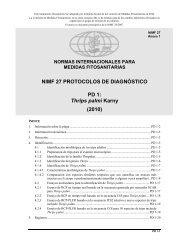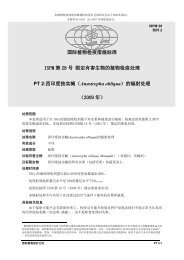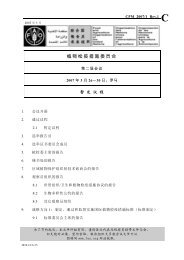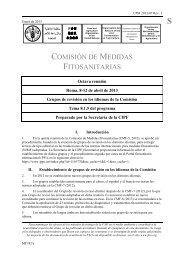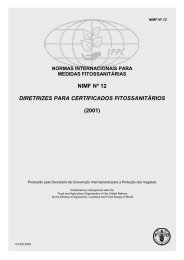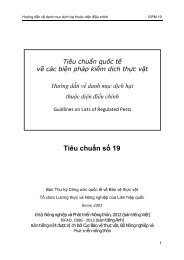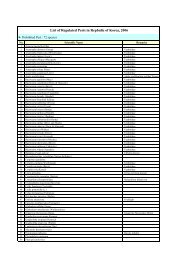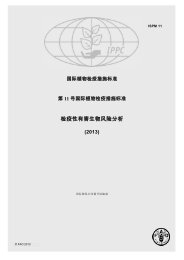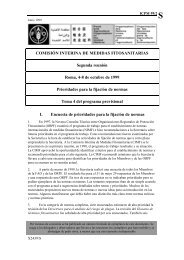ISPM 27 DIAGNOSTIC PROTOCOLS DP 2: Plum pox virus (2012)
ISPM 27 DIAGNOSTIC PROTOCOLS DP 2: Plum pox virus (2012)
ISPM 27 DIAGNOSTIC PROTOCOLS DP 2: Plum pox virus (2012)
Create successful ePaper yourself
Turn your PDF publications into a flip-book with our unique Google optimized e-Paper software.
This diagnostic protocol was adopted by the Seventh Session of the Commission on Phytosanitary Measures in March <strong>2012</strong>.The annex is a prescriptive part of <strong>ISPM</strong> <strong>27</strong>:2006.<strong>ISPM</strong> <strong>27</strong>Annex 2INTERNATIONAL STANDARDS FORPHYTOSANITARY MEASURES<strong>ISPM</strong> <strong>27</strong> <strong>DIAGNOSTIC</strong> <strong>PROTOCOLS</strong><strong>DP</strong> 2:<strong>Plum</strong> <strong>pox</strong> <strong>virus</strong>(<strong>2012</strong>)CONTENTS1. Pest Information ..................................................................................................................... <strong>DP</strong> 2-32. Taxonomic Information .......................................................................................................... <strong>DP</strong> 2-33. Detection and Identification ................................................................................................... <strong>DP</strong> 2-33.1 Biological detection ................................................................................................ <strong>DP</strong> 2-53.2 Serological detection and identification .................................................................. <strong>DP</strong> 2-53.2.1 Double-antibody sandwich indirect enzyme-linked immunosorbent assay ............ <strong>DP</strong> 2-53.2.2 Double-antibody sandwich enzyme-linked immunosorbent assay ......................... <strong>DP</strong> 2-63.3 Molecular detection and identification .................................................................... <strong>DP</strong> 2-63.3.1 Reverse transcription-polymerase chain reaction .................................................... <strong>DP</strong> 2-63.3.2 Immunocapture reverse transcription-polymerase chain reaction ........................... <strong>DP</strong> 2-73.3.3 Co-operational reverse transcription-polymerase chain reaction ............................ <strong>DP</strong> 2-73.3.4 Real-time reverse transcription-polymerase chain reaction .................................... <strong>DP</strong> 2-84. Identification of Strains ........................................................................................................ <strong>DP</strong> 2-104.1 Serological identification of strains ....................................................................... <strong>DP</strong> 2-104.2 Molecular identification of strains ........................................................................ <strong>DP</strong> 2-114.2.1 Reverse transcription-polymerase chain reaction .................................................. <strong>DP</strong> 2-114.2.2 Immunocapture reverse transcription-polymerase chain reaction ......................... <strong>DP</strong> 2-114.2.3 Co-operational reverse transcription-polymerase chain reaction .......................... <strong>DP</strong> 2-114.2.4 Real-time reverse transcription-polymerase chain reaction .................................. <strong>DP</strong> 2-125. Records ................................................................................................................................. <strong>DP</strong> 2-136. Contact Points for Further Information ................................................................................ <strong>DP</strong> 2-13<strong>DP</strong> 2-1
<strong>DP</strong> 2:<strong>2012</strong>Diagnostic protocols for regulated pests7. Acknowledgements .............................................................................................................. <strong>DP</strong> 2-148. References ............................................................................................................................ <strong>DP</strong> 2-14<strong>DP</strong> 2-2
<strong>DP</strong> 2:<strong>2012</strong>Diagnostic protocols for regulated pestsPPV symptoms may appear on leaves, shoots, bark, petals, fruits and stones in the field. They areusually distinct on leaves early in the growing season and include mild light-green discoloration;chlorotic spots, bands or rings; vein clearing or yellowing; or leaf deformation. Some of these leafsymptoms are similar to those caused by other <strong>virus</strong>es, such as American plum line pattern <strong>virus</strong>.Prunus cerasifera cv. GF 31 shows rusty-brown corking and cracking of the bark. Flower symptomscan occur on petals (discoloration) of some P. persica cultivars when infected with PPV-M or in P.glandulosa infected with PPV-D. Infected fruits show chlorotic spots or lightly pigmented yellowrings or line patterns. Fruits may become deformed or irregular in shape and develop brown ornecrotic areas under the discoloured rings. Some fruit deformations, especially in P. armeniaca and P.domestica, are similar to those caused by Apple chlorotic leaf spot <strong>virus</strong>. Diseased fruits may showinternal browning and gummosis of the flesh and reduced quality. In severe cases the diseased fruitsdrop prematurely from the tree. In general the fruits of early maturing cultivars show more markedsymptoms than those of late maturing cultivars. Stones from diseased fruits of P. armeniaca showtypical pale rings or spots. The alcohol or spirits produced from diseased fruits are unmarketableowing to an undesirable flavour. Symptom development and intensity depend strongly on the hostplant and climatic conditions; for example the <strong>virus</strong> may be latent for several years in cold climates.General guidance on sampling methodologies is described in <strong>ISPM</strong> 31:2008 (Methodologies forsampling of consignments). Appropriate sample selection is critical for PPV detection. Samplingshould take into account <strong>virus</strong> biology and local climatic conditions, in particular the weatherconditions during the growing season. If typical symptoms are present, collect flowers, leaves or fruitsshowing symptoms. In symptomless plants, samples should be taken from at least one-year-old shootswith mature leaves or fully expanded leaves collected from the middle of each of the main branches(detection is not reliable in shoots less than one year old). Samples should be collected from at leastfour different sites (e.g. four branches or four leaves) in each plant; this is critical because of theuneven distribution of PPV. Sampling should not be done during months with the highesttemperatures. Tests on samples collected in the autumn are less reliable than tests done on samplescollected earlier in the spring. Plant material should preferably be collected from the internal parts ofthe tree canopy. In springtime, samples can be flowers, shoots with fully expanded leaves or fruits. Insummer and autumn, mature leaves and the skin of mature fruits collected from the field or packinghouses can be used for analysis. Flowers, leaves, shoots and fruit skin can be stored at 4 °C for notmore than 10 days before processing. Fruits can be stored for one month at 4 °C before processing. Inwinter dormant buds or bark tissues from the basal part of twigs, shoots, or branches, or completespurs can be selected.Detection of PPV can be achieved using a biological, serological or molecular test; identificationrequires either a serological or molecular test. A serological or molecular test is the minimumrequirement to detect and identify PPV (e.g. during routine diagnosis of a pest widely established in acountry). In instances where the national plant protection organization (NPPO) requires additionalconfidence in the identification of PPV (e.g. detection in an area where the <strong>virus</strong> is not known to occuror detection in a consignment originating in a country where the pest is declared to be absent), furthertests may be done. Where the initial identification was done using a molecular method, subsequenttests should use serological techniques and vice versa. Further tests may also be done to identify thestrain of PPV present. In all cases, positive and negative controls must be included in the tests. Therecommended techniques are described in the following sections.In some circumstances (e.g. during the routine diagnosis of a pest widely established in a country)multiple plants may be tested simultaneously using a bulked sample derived from a number of plants.The decision to test individual or multiple plants depends on the <strong>virus</strong> concentration in the plants andthe level of confidence required by the NPPO.In this diagnostic protocol, methods (including reference to brand names) are described as published,as these define the original level of sensitivity, specificity and/or reproducibility achieved. Laboratoryprocedures presented in the protocols may be adjusted to the standards of individual laboratories,provided that they are adequately validated.<strong>DP</strong> 2-4
Diagnostic protocols for regulated pests <strong>DP</strong> 2:<strong>2012</strong>3.1 Biological detectionThe main indicator plants used for PPV indexing are seedlings of P. cerasifera cv. GF31, P. persicacv. GF305, P. persica × P. davidiana cv. Nemaguard, or P. tomentosa. Indicator plants are raised fromseed, planted in a well-drained soil mixture and maintained in an insect-proof greenhouse between18 °C and 25 °C until they are large enough to graft (usually 25–30 cm high with a diameter of 3–4mm). Alternatively seedlings of other Prunus species may be grafted with indicator plant scions. Theindicators must be graft-inoculated according to conventional methods such as bud grafting(Desvignes, 1999), using at least four replicates per indicator plant. The grafted indicator plants aremaintained in the same conditions and, after 3 weeks, are pruned to a few centimetres above the topgraft (Gentit, 2006). The grafted plants should be inspected for symptoms for at least 6 weeks.Symptoms, in particular chlorotic banding and patterns, are observed on the new growth after 3–4weeks and must be compared with positive and healthy controls. Illustrations of symptoms caused byPPV on indicator plants can be found in Damsteegt et al. (1997; 2007) and Gentit (2006).There are no quantitative data published on the specificity, sensitivity or reliability of grafting. Themethod is used widely in certification schemes and is considered a sensitive method of detection.However, it is not a rapid test (symptom development requires several weeks post-inoculation), it canonly be used to test budwood, it requires dedicated facilities such as temperature-controlledgreenhouse space, and the symptoms observed may be confused with those of other graft-transmissibleagents. Moreover, there are asymptomatic strains that do not induce symptoms and thus are notdetectable on indicator plants.3.2 Serological detection and identificationEnzyme-linked immunosorbent assays (ELISA) are highly recommended for screening large numbersof samples.For sample processing, approximately 0.2–0.5 g of fresh plant material is cut into small pieces andplaced in a suitable tube or plastic bag. The sample is homogenized in approximately 4–10 ml (1:20w/v) of extraction buffer using an electrical tissue homogenizer, or a manual roller, hammer or similartool. The extraction buffer is phosphate-buffered saline (PBS) pH 7.2–7.4, containing 2%polyvinylpyrrolidone and 0.2% sodium diethyl dithiocarbamate (Cambra et al., 1994), or analternative suitably validated buffer. Plant material should be homogenized thoroughly and used fresh.3.2.1 Double-antibody sandwich indirect enzyme-linked immunosorbent assayDouble-antibody sandwich indirect enzyme-linked immunosorbent assay (DASI)-ELISA, also calledtriple-antibody sandwich (TAS)-ELISA, should be performed according to Cambra et al. (1994) usinga specific monoclonal antibody such as 5B-IVIA, following the manufacturer’s instructions.5B-IVIA is currently the only monoclonal antibody demonstrated to detect all strains of PPV withhigh reliability, specificity and sensitivity (Cambra et al., 2006a). In a DIAGPRO ring-test done by 17laboratories using a panel of 10 samples, PPV-infected (PPV-D, PPV-M and PPV-D+M) and healthysamples from France and Spain, DASI-ELISA using the 5B-IVIA monoclonal antibody was 95%accurate (number of true negatives and true positives diagnosed by the technique/number of samplestested). This accuracy was greater than that achieved with either immunocapture reverse transcriptionpolymerasechain reaction (IC-RT-PCR) which was 82% accurate, or co-operational RT-PCR (Co-RT-PCR) which was 94% accurate (Cambra et al., 2006c; Olmos et al., 2007). The proportion of truenegatives (number of true negatives diagnosed by the technique/number of healthy plants) identifiedby DASI-ELISA using the 5B-IVIA monoclonal antibody was 99.0%, compared with real-time RT-PCR using purified nucleic acid (89.2%) or spotted samples (98.0%), or IC-RT-PCR (96.1%). Capoteet al. (2009) also reported that there is a 98.8% probability that a positive result obtained in winterwith DASI-ELISA using the 5B-IVIA monoclonal antibody was a true positive.<strong>DP</strong> 2-5
<strong>DP</strong> 2:<strong>2012</strong>Diagnostic protocols for regulated pests3.2.2 Double-antibody sandwich enzyme-linked immunosorbent assayThe conventional or biotin/streptavidin system of double-antibody sandwich (DAS)-ELISA should beperformed using kits based on the specific monoclonal antibody 5B-IVIA or on polyclonal antibodiesthat have been demonstrated to detect all strains of PPV without cross-reacting with other <strong>virus</strong>es orhealthy plant material (Cambra et al., 2006a; Capote et al., 2009). The test should be done accordingto the manufacturer’s instructions.Whereas the 5B-IVIA monoclonal antibody detects all PPV strains specifically, sensitively andreliably, some polyclonal antibodies are not specific and have limited sensitivity (Cambra et al., 1994;Cambra et al., 2006a). Therefore the use of additional methods is recommended in situations wherepolyclonal antibodies have been used in an assay and the NPPO requires additional confidence in theidentification of PPV.3.3 Molecular detection and identificationMolecular methods using reverse transcription-polymerase chain reaction (RT-PCR) may be moreexpensive and/or time consuming than serological techniques, especially for large-scale testing.However, molecular methods, especially real-time RT-PCR, are generally more sensitive thanserological techniques. The use of real-time RT-PCR also avoids the need for any post-amplificationprocessing (e.g. gel electrophoresis) and is therefore quicker with less opportunity for contaminationthan conventional PCR.With the exception of immunocapture (IC)-RT-PCR (for which RNA isolation is not required), RNAextraction should be done using appropriately validated protocols. The samples should be placed inindividual plastic bags to avoid cross-contamination during extraction. Alternatively for real-time RT-PCR, spotted plant extracts, printed tissue sections or squashes of plant material can be immobilizedon blotting paper or nylon membranes and analysed by real-time RT-PCR (Olmos et al., 2005; Osmanand Rowhani, 2006; Capote et al., 2009). It is not recommended to use spotted or tissue-printedsamples in conventional PCR because of the lower sensitivity compared with real-time RT-PCR.Each method describes the volume of extracted sample that should be used as a template. Dependingon the sensitivity of the method the minimum concentration of template required to detect PPV variesas follows: RT-PCR, 100 fg RNA template ml-1; Co-RT-PCR, 1 fg RNA template ml-1; and real-timeRT-PCR, 2 fg RNA template ml-1.3.3.1 Reverse transcription-polymerase chain reactionThe RT-PCR primers used in this assay are either the primers of Wetzel et al. (1991):P1 (5′-ACC GAG ACC ACT ACA CTC CC-3′)P2 (5′-CAG ACT ACA GCC TCG CCA GA-3′)or the primers of Levy and Hadidi (1994):3′NCR sense (5′-GTA GTG GTC TCG GTA TCT ATC ATA-3′)3′NCR antisense (5′-GTC TCT TGC ACA AGA ACT ATA ACC-3′).The 25 μl reaction mixture is composed as follows: 1 μM of each primer (P1/P2 or the 3′NCR primerpair), 250 μM dNTPs, 1 unit AMV reverse transcriptase, 0.5 units Taq DNA polymerase, 2.5 μl 10 ×Taq polymerase buffer, 1.5 mM MgCl 2 , 0.3% Triton X-100 and 5 μl RNA template. The reaction isperformed under the following thermocycling conditions: 45 min at 42 °C, 2 min at 94 ºC, 40 cycles of30 s at 94 °C, 30 s at either 60 °C (P1/P2 primers) or 62 °C (3′NCR primers), and 1 min at 72 °C,followed by a final extension for 10 min at 72 °C. The PCR products are analysed by gelelectrophoresis. The P1/P2 and 3′NCR primers produce a 243 base pair (bp) and 220 bp amplicon,respectively.<strong>DP</strong> 2-6
Diagnostic protocols for regulated pests <strong>DP</strong> 2:<strong>2012</strong>The method of Wetzel et al. (1991) was evaluated by testing PPV isolates from Mediterranean areas(Cyprus, Egypt, France, Greece, Spain and Turkey). The assay was able to detect 10 fg of viral RNA,corresponding to 2 000 viral particles (Wetzel et al., 1991). The method of Levy and Hadidi (1994)was evaluated using PPV isolates from Egypt, France, Germany, Greece, Hungary, Italy, Spain andRomania.3.3.2 Immunocapture reverse transcription-polymerase chain reactionThe immunocapture phase should be performed according to Wetzel et al. (1992), using plant sapextracted as in section 3.2 using individual tubes or plastic bags to avoid contamination.Prepare a dilution (1 μg ml -1 ) of polyclonal antibodies or PPV-specific monoclonal antibody (5B-IVIA) in carbonate buffer pH 9.6. Add 100 μl of the diluted antibodies into PCR tubes and incubate at37 °C for 3 h. Wash the tubes twice with 150 μl of sterile PBS-Tween (washing buffer). Rinse thetubes twice with RNase-free water. Clarify 100 μl of plant extract (see section 3.2) by centrifugation(5 min at 15 500 × g), and add the supernatant to the coated PCR tubes. Incubate for 2 h on ice or at37 °C. Wash the tubes three times with 150 μl of sterile PBS-Tween. Prepare the RT-PCR reactionmixture as described in section 3.3.1 using the primers of Wetzel et al. (1992), and add directly to thecoated PCR tubes. Perform the amplification as described in section 3.3.1.IC-RT-PCR generally requires the use of specific antibodies, although direct-binding methods mayeliminate this requirement. IC-RT-PCR using the 5B-IVIA monoclonal antibody has been validated ina DIAGPRO ring-test showing an accuracy of 82% for PPV detection (Cambra et al., 2006c; Olmos etal., 2007). Capote et al. (2009) reported that there is a 95.8% probability that a positive result obtainedin winter with IC-RT-PCR using the 5B-IVIA monoclonal antibody was a true positive.3.3.3 Co-operational reverse transcription-polymerase chain reactionThe RT-PCR primers used in this co-operational (Co)-RT-PCR assay are the primers of Olmos,Bertolini and Cambra (2002):Internal primer P1 (5′-ACC GAG ACC ACT ACA CTC CC-3′)Internal primer P2 (5′-CAG ACT ACA GCC TCG CCA GA-3′)External primer P10 (5′-GAG AAA AGG ATG CTA ACA GGA-3′)External primer P20 (5′-AAA GCA TAC ATG CCA AGG TA-3′).The 25 μl reaction mixture is composed as follows: 0.1 μM of P1 and P2 primers, 0.05 μM of P10 andP20 primers, 400 μM dNTPs, 2 units AMV reverse transcriptase, 1 unit Taq DNA polymerase, 2 μl10 × reaction buffer, 3 mM MgCl 2 , 5% DMSO, 0.3% Triton X-100 and 5 μl RNA template. The RT-PCR is performed under the following thermocycling conditions: 45 min at 42 °C, 2 min at 94 °C, 60cycles of 15 s at 94 °C, 15 s at 50 °C, and 30 s at 72 °C, followed by a final extension for 10 min at72 °C.The RT-PCR reaction is coupled to a colorimetric detection of amplicons using a 3´digoxigenin(DIG)-labelled PPV universal probe (5′-TCG TTT ATT TGG CTT GGA TGG AA-DIG-3′) asfollows. Denature the amplified cDNA at 95 °C for 5 min and immediately place on ice. Place 1 μl ofsample on a nylon membrane. Dry the membrane at room temperature and UV cross-link in atransilluminator for 4 min at 254 nm. For pre-hybridization, place the membrane in a hybridizationtube at 60 °C for 1 h using a standard hybridization buffer. Discard the solution and perform thehybridization by mixing the 3′DIG-labelled probe with standard hybridization buffer at a finalconcentration of 10 pmol ml −1 , before incubating for 2 h at 60 °C. Wash the membrane twice for15 min at room temperature with 2 × washing solution, and twice for 15 min at room temperature with0.5 × washing solution. Equilibrate the membrane for 2 min in washing buffer before soaking for30 min in sterilized 1%blocking solution (1 g blocking reagent dissolved in 100 ml maleic acidbuffer). Incubate the membrane at room temperature with anti-DIG-alkaline phosphatase conjugateantibodies at a working concentration of 1:5 000 (150 units litre −1 ) in 1% blocking solution (w/v) for<strong>DP</strong> 2-7
<strong>DP</strong> 2:<strong>2012</strong>Diagnostic protocols for regulated pests30 min. Wash the membrane twice for 15 min with washing buffer, and equilibrate for 2 min withdetection buffer (100 mM Tris-HCl, 100 mM NaCl, pH 9.5). The substrate solution is prepared bymixing 45 μl NBT solution (75 mg ml -1 nitro blue tetrazolium salt in 70% (v/v) dimethylformamide)and 35 μl BCIP solution (50 mg ml -1 5-bromo-4chloro-3indolyl phosphate toluidinium salt in 100%dimethylformamide) in 10 ml of detection buffer. After incubation with the substrate stop the reactionby washing with water.This method was 100 times more sensitive than RT-PCR using the assay of Wetzel et al. (1991)(Olmos, Bertolini and Cambra, 2002). The method was validated in the DIAGPRO ring-test and hadan accuracy of 94% (Cambra et al., 2006c; Olmos et al., 2007).3.3.4 Real-time reverse transcription-polymerase chain reactionReal-time RT-PCR can be performed using either TaqMan or SYBR Green I. Two TaqMan methodshave been described for universal detection of PPV (Schneider et al., 2004; Olmos et al., 2005). Theprimers and TaqMan probe used in the first assay are those reported by Schneider et al. (2004):Forward primer (5′-CCA ATA AAG CCA TTG TTG GAT C-3′)Reverse primer (5′-TGA ATT CCA TAC CTT GGC ATG T-3′)TaqMan probe (5′-FAM-CTT CAG CCA CGT TAC TGA AAT GTG CCA-TAMRA-3′).The 25 μl reaction mixture is composed as follows: 1 × reaction mix (0.2 mM of each dNTP and1.2 mM MgSO 4 ), 200 nM of forward and reverse primers, 100 nM TaqMan probe, 4.8 mM MgSO 4 ,0.5 μl RT/Platinum ® Taq mix (Superscript One-Step RT-PCR with Platinum ® Taq kit; Invitrogen) 1and 5 μl RNA template. The RT-PCR is performed under the following thermocycling conditions:15 min at 52 °C, 5 min at 95 °C, 60 cycles of 15 s at 95 °C, and 30 s at 60 °C. The PCR products areanalysed in real-time according to the equipment manufacturer’s instructions.The method of Schneider et al. (2004) was evaluated by testing PPV isolates from the United States,strains PPV-C, PPV-D, PPV-EA and PPV-M, and eight other viral species. The method was specificand able to detect consistently 10–20 fg of viral RNA (Schneider et al., 2004). The method could alsodetect PPV in a number of hosts and in the leaves, stems, buds and roots of P. persica.The primers and TaqMan probe used in the second assay are those reported by Olmos et al. (2005):P241 primer (5′-CGT TTA TTT GGC TTG GAT GGA A-3′)P316D primer (5′-GAT TAA CAT CAC CAG CGG TGT G-3′)P316M primer (5′-GAT TCA CGT CAC CAG CGG TGT G-3′)PPV-DM probe (5′-FAM-CGT CGG AAC ACA AGA AGA GGA CAC AGA-TAMRA-3′).The 25 μl reaction mixture is composed as follows: 1 μM of P241 primer, 0.5 μM each of P316D andP316M primers, 200 nM TaqMan probe, 1 × TaqMan Universal PCR Master Mix (AppliedBiosystems) 2 , 1 × MultiScribe and RNase Inhibitor Mix (Applied Biosystems) 3 and 5 μl RNAtemplate. The RT-PCR is performed under the following thermocycling conditions: 30 min at 48 °C,1The use of the brand Invitrogen for the Superscript One-Step RT-PCR with Platinum ® Taq kit in thisdiagnostic protocol implies no approval of them to the exclusion of others that may also be suitable. Thisinformation is given for the convenience of users of this protocol and does not constitute an endorsement by theCPM of the chemical, reagent and/or equipment named. Equivalent products may be used if they can be shownto lead to the same results.2The use of the brand Applied Biosystems for the TaqMan Universal PCR Master Mix and the MultiScribe andRNase Inhibitor Mix in this diagnostic protocol implies no approval of them to the exclusion of others that mayalso be suitable. This information is given for the convenience of users of this protocol and does not constitute anendorsement by the CPM of the chemical, reagent and/or equipment named. Equivalent products may be used ifthey can be shown to lead to the same results.3 See footnote 2.<strong>DP</strong> 2-8
Diagnostic protocols for regulated pests <strong>DP</strong> 2:<strong>2012</strong>10 min at 95 °C, 40 cycles of 15 s at 95 °C, and 60 s at 60 °C. The PCR products are analysed in realtimeaccording to the equipment manufacturer’s instructions.The method of Olmos et al. (2005) was evaluated using three isolates each of PPV-D and PPV-M, andwas 1 000 times more sensitive than DASI-ELISA using the 5B-IVIA monoclonal antibody. Theproportion of true positives (number of true positives diagnosed by the technique/number of PPVinfectedplants) identified correctly by real-time RT-PCR using TaqMan (Olmos et al., 2005) andpurified nucleic acid was 97.5%, compared with real-time RT-PCR using spotted samples (93.6%),immunocapture RT-PCR (91.5%) or DASI-ELISA using the 5B-IVIA monoclonal antibody (86.6%)(Capote et al., 2009).Varga and James (2005) described a SYBR Green I method for the simultaneous detection of PPV andidentification of D and M strains:P1 (5′-ACC GAG ACC ACT ACA CTC CC-3′)PPV-U (5′-TGA AGG CAG CAG CAT TGA GA-3′)PPV-FD (5′-TCA ACG ACA CCC GTA CGG GC-3′)PPV-FM (5′-GGT GCA TCG AAA ACG GAA CG-3′)PPV-RR (5′-CTC TTC TTG TGT TCC GAC GTT TC-3′).The following internal control primers may be included to ensure the correct performance of the assay:Nad5-F (5′-GAT GCT TCT TGG GGC TTC TTG TT-3′)Nad5-R (5′-CTC CAG TCA CCA ACA TTG GCA TAA-3′).A two-step RT-PCR protocol is used. The RT reaction is composed as follows: 2 μl of 10 μM P1primer, 2 μl of 10 μM Nad5-R primer, 4 μg total RNA and 5 μl water. Incubate at 72 °C for 5 min,place on ice. Add 4 μl 5 × first strand buffer (Invitrogen) 4 , 2 μl 0.1 M DTT, 1 μl 10 mM dNTPs, 0.5 μlRNaseOUT (40 units μl −1 ) (Invitrogen) 5 , 1 μl Superscript II (Invitrogen) 6 and 2.5 μl water.Incubate at 42 °C for 60 min followed by 99 °C for 5 min. The 24 μl PCR reaction mixture iscomposed as follows: 400 nM PPV-U primer, 350 nM PPV-FM primer, 150 nM PPV-FD primer, 200nM PPV-RR primer, 100 nM Nad5-F primer, 100 nM Nad5-R primer, 200 μM dNTPs, 2mM MgCl 2 ,1 × Karsai buffer (Karsai et al., 2002), 1:42 000 SYBR Green I (Sigma) 7 and 0.1 μl Platinum ® TaqDNA high fidelity polymerase (Invitrogen) 8 . The reaction mixture and 1 μl of diluted cDNA (1:4) areadded to a sterile PCR tube. The PCR is performed under the following thermocycling conditions:2 min at 95 °C, 39 cycles of 15 s at 95 °C, and 60 s at 60 °C. Melting curve analysis is done byincubation at 60 °C to 95 °C at 0.1 °C s −1 with a smooth curve setting averaging 1 point. Following theconditions of Varga and James (2005), the melting temperatures for each product are:Universal PPV detection (74 bp fragment): 80.08–81.52 °CD strains (114 bp fragment): 84.3–84.43 °CM strains (380 bp fragment): 85.34–86.11 °CInternal control (181 bp fragment): 82.45–82.63 °C.4 The use of the brand Invitrogen for the first strand buffer, RNaseOUT, Superscript II and Platinum ® TaqDNA high fidelity polymerase in this diagnostic protocol implies no approval of them to the exclusion of othersthat may also be suitable. This information is given for the convenience of users of this protocol and does notconstitute an endorsement by the CPM of the chemical, reagent and/or equipment named. Equivalent productsmay be used if they can be shown to lead to the same results.5 See footnote 4.6 See footnote 4.7 The use of the brand Sigma for SYBR Green I in this diagnostic protocol implies no approval of it to theexclusion of others that may also be suitable. This information is given for the convenience of users of thisprotocol and does not constitute an endorsement by the CPM of the chemical, reagent and/or equipment named.Equivalent products may be used if they can be shown to lead to the same results.8 See footnote 4.<strong>DP</strong> 2-9
<strong>DP</strong> 2:<strong>2012</strong>Diagnostic protocols for regulated pestsThe method of Varga and James (2005) was evaluated using isolates of PPV-C, PPV-D, PPV-EA,PPV-M and an uncharacterized strain in Nicotiana and Prunus species.4. Identification of StrainsThis section describes additional methods (using DASI-ELISA, RT-PCR, Co-RT-PCR and real-timeRT-PCR) for identification of PPV strains (see Figure 1). Strain identification is not an essentialcomponent of PPV identification but an NPPO may wish to determine the identity of the strain toassist in predicting its epidemiological behaviour.Given the variability of PPV, techniques other than sequencing or some PCR-based assays (see below)may provide erroneous results with a small percentage of isolates. However, it is generally possible todiscriminate the D and M types of PPV using the serological or molecular techniques described(Cambra et al., 2006a; Candresse and Cambra, 2006; Capote et al., 2006).PPV Identifiedusing serological or molecular test described in section 3Serological testDASI-ELISA with C-, D-, EA- or M- specific monoclonal antibodies; orMolecular testRT-PCR (P1/PD/PM or mD5/mM3 primers), IC-RT-PCR (P1/PD/PM primers), Co-PCR (P10/P20/P1/P2primers) and hybridization with D or M specific probes, or real-time RT-PCR (specific for C, D, EA, M or WPositiveNegative<strong>Plum</strong> <strong>pox</strong> <strong>virus</strong> present:type C, D, EA, M, Rec, T or W present<strong>Plum</strong> <strong>pox</strong> <strong>virus</strong> present:atypical type C, D, EA, M, Rec, T or Wpresent, or other undescribed typeFigure 1: Methods for the identification of strains of <strong>Plum</strong> <strong>pox</strong> <strong>virus</strong>.Further tests may be done in instances where the NPPO requires additional confidence in theidentification of PPV type. Sequencing of the complete PPV genome, or complete or partial coatprotein, P3-6K1 and cytoplasmic inclusion protein genes should also be done where atypical orundescribed types are present.4.1 Serological identification of strainsDASI-ELISA for differentiation between the two main PPV types (D and M) should be performedaccording to Cambra et al. (1994), using D- and M-specific monoclonal antibodies (Cambra et al.,1994; Boscia et al., 1997), according to the manufacturer’s instructions.This method has been validated in the DIAGPRO ring-test showing an accuracy of 84% for PPV-Ddetection and 89% for PPV-M detection (Cambra et al., 2006c; Olmos et al., 2007). The 4Dmonoclonal antibody is PPV-D specific but does not react with all PPV-D isolates. In addition, the ALmonoclonal antibody used for PPV-M detection reacts with isolates belonging to strains M, Rec and Tsince these groups share the same coat protein sequence. Therefore a molecular test is required todifferentiate between M, Rec and T types detected using an M-specific monoclonal antibody.<strong>DP</strong> 2-10
Diagnostic protocols for regulated pests <strong>DP</strong> 2:<strong>2012</strong>Serological identification of PPV isolates from EA and C groups may be done by DASI-ELISA usingthe EA- and/or the C-specific monoclonal antibodies described by Myrta et al. (1998, 2000). However,these tests need to be validated.4.2 Molecular identification of strains4.2.1 Reverse transcription-polymerase chain reactionPPV-D and PPV-M are identified using the primers described by Olmos et al. (1997):P1 (5′-ACC GAG ACC ACT ACA CTC CC-3′)PD (5′-CTT CAA CGA CAC CCG TAC GG-3′) or PM (5′-CTT CAA CAA CGC CTGTGC GT -3′).The 25 μl reaction mixture is composed as follows: 1 μM of P1 primer, 1 μM of either PD or PMprimer, 250 μM dNTPs, 1 unit AMV reverse transcriptase (10 units μl −1 ), 0.5 units Taq DNApolymerase (5 units μl −1 ), 2.5 μl 10 × Taq polymerase buffer, 1.5 mM MgCl 2 , 0.3% Triton X-100, 2%formamide and 5 μl RNA template. The RT-PCR is performed under the following thermocyclingconditions: 45 min at 42 °C, 2 min at 94 °C, 40 cycles of 30 s at 94 °C, 30 s at 60 °C, and 1 min at72 °C, followed by a final extension for 10 min at 72 °C. The PCR products are analysed by gelelectrophoresis. The P1/PD and P1/PM primers produce a 198 bp amplicon. The method wasevaluated using six isolates of PPV-D and four PPV-M isolates.PPV-Rec is identified using the mD5/mM3 Rec-specific primers described by Šubr, Pittnerova andGlasa (2004):mD5 (5′-TAT GTC ACA TAA AGG CGT TCT C-3′)mM3 (5′-CAT TTC CAT AAA CTC CAA AAG AC-3′).The 25 μl reaction mixture is composed as follows (modified from Šubr, Pittnerova and Glasa, 2004):1 μM of each primer, 250 μM dNTPs, 1 unit AMV reverse transcriptase (10 units μl −1 ), 0.5 units TaqDNA polymerase (5 units μl −1 ), 2.5 μl 10 × Taq polymerase buffer, 2.5 mM MgCl 2 , 0.3% Triton X-100 and 5 μl of extracted RNA (see section 3.3). The PCR product of 605 bp is analysed by gelelectrophoresis.4.2.2 Immunocapture reverse transcription-polymerase chain reactionThe immunocapture phase should be performed as described in section 3.3.2. The PCR reactionmixture is added directly to the coated PCR tubes. Identification of PPV-D and PPV-M detection isdone as described in section 4.2.1.4.2.3 Co-operational reverse transcription-polymerase chain reactionIdentification of PPV-D or PPV-M should be done as described in section 3.3.3 using 3′DIG-labelledprobes specific for D and M strains (Olmos, Bertolini and Cambra, 2002):PPV-D Specific Probe: 5′-CTT CAA CGA CAC CCG TAC GGG CA-DIG-3′PPV-M Specific Probe: 5′-AAC GCC TGT GCG TGC ACG T-DIG-3′.The prehybridization and hybridization steps are performed at 50 °C with standard prehybridizationand hybridization buffers + 30% formamide (for PPV-D identification) and + 50% formamide (forPPV-M identification). The blocking solution is used at 2% (w/v).<strong>DP</strong> 2-11
<strong>DP</strong> 2:<strong>2012</strong>Diagnostic protocols for regulated pests4.2.4 Real-time reverse transcription-polymerase chain reactionPPV-D and PPV-M are specifically identified using either SYBR Green I chemistry according to themethod of Varga and James (2005) (see section 3.3.4) or the TaqMan method described by Capote etal. (2006).The primers and TaqMan probes used in the method of Capote et al. (2006) are:PPV-MGB-F primer (5′-CAG ACT ACA GCC TCG CCA GA-3′)PPV-MGB-R primer (5′-CTC AAT GCT GCT GCC TTC AT-3′)MGB-D probe (5′- FAM-TTC AAC GAC ACC CGT A-MGB-3′)MGB-M probe (5′-FAM-TTC AAC AAC GCC TGT G-MGB-3′).The 25 μl reaction mixture is composed as follows: 1 μM of each primer, 150 nM MGB-D or MGB-MFAM probe, 1 × TaqMan Universal PCR Master Mix (Applied Biosystems) 9 , 1 × MultiScribe andRNase Inhibitor Mix (Applied Biosystems) 10 and 5 μl of RNA template (see section 3.3). The RT-PCRis performed under the following thermocycling conditions: 30 min at 48 °C, 10 min at 95 °C, 40cycles of 15 s at 95 °C, and 60 s at 60 °C. The PCR products are analysed in real time according to themanufacturer’s instructions. The method has been evaluated using 12 isolates each of PPV-D andPPV-M, and 14 samples co-infected with both types.PPV-C, PPV-EA and PPV-W are specifically identified using SYBR Green I chemistry according tothe method of Varga and James (2006). The primers used in this method are:P1 (5′-ACC GAG ACC ACT ACA CTC CC-3′)PPV-U (5′-TGA AGG CAG CAG CAT TGA GA-3′)PPV-RR (5′-CTC TTC TTG TGT TCC GAC GTT TC-3′).The following internal control primers may be included to ensure the correct performance of the assay:Nad5-F (5′-GAT GCT TCT TGG GGC TTC TTG TT-3′)Nad5-R (5′-CTC CAG TCA CCA ACA TTG GCA TAA-3′).The 25 μl RT-PCR reaction is composed as follows: 2.5 μl of a 1:10 (v/v) water dilution of extractedRNA (see section 3.3) and 22.5 μl of master mix. The master mix has the following composition:2.5 μl of Karsai Buffer (Karsai et al., 2002); 0.5 μl each of 5 μM primers PPV-U, PPV-RR or P1,Nad5R and Nad5F; 0.5 μl of 10 mM dNTPs; 1 μl of 50 mM MgCl 2 ; 0.2 μl of RNaseOUT (40 unitsμl −1 ; Invitrogen) 11 ; 0.1 μl of Superscript III (200 units μl -1 ; Invitrogen) 12 ; 0.1 μl of Platinum ® TaqDNA high fidelity polymerase (5 units μl -1 , Invitrogen) 13 ; and 1 μl of 1:5 000 (in TE, pH 7.5) SYBRGreen I (Sigma) 14 in 16.1 μl water. The reaction is performed under the following thermocycling9 The use of the brand Applied Biosystems for the TaqMan Universal PCR Master Mix and the MultiScribe andRNase Inhibitor Mix in this diagnostic protocol implies no approval of them to the exclusion of others that mayalso be suitable. This information is given for the convenience of users of this protocol and does not constitute anendorsement by the CPM of the chemical, reagent and/or equipment named. Equivalent products may be used ifthey can be shown to lead to the same results.10 See footnote 9.11 The use of the brand Invitrogen for RNaseOUT , Superscript II and Platinum ® Taq DNA high fidelitypolymerase in this diagnostic protocol implies no approval of them to the exclusion of others that may also besuitable. This information is given for the convenience of users of this protocol and does not constitute anendorsement by the CPM of the chemical, reagent and/or equipment named. Equivalent products may be used ifthey can be shown to lead to the same results.12 See footnote11.13 See footnote 11.<strong>DP</strong> 2-12
Diagnostic protocols for regulated pests <strong>DP</strong> 2:<strong>2012</strong>conditions: 10 min at 50 °C, 2 min at 95 °C, 29 cycles of 15 s at 95 °C, and 60 s at 60 °C. Meltingcurve analysis is performed by incubation at 60 °C to 95 °C at 0.1 °C s −1 melt rates with a smoothcurve setting averaging 1 point. Following the conditions of Varga and James (2006), the meltingtemperatures for each product are:C strain (74 bp fragment): 79.84 °CEA strain (74 bp fragment): 81.<strong>27</strong> °CW strain (74 bp fragment): 80.68 °C.This method was evaluated using one isolate each of PPV-C, PPV-D, PPV-EA and PPV-W.5. RecordsThe records required to be kept are listed in section 2.5 of <strong>ISPM</strong> <strong>27</strong>:2006.In instances where other contracting parties may be affected by the results of the diagnosis, inparticular in cases of non-compliance and where the <strong>virus</strong> is found in an area for the first time, thefollowing additional material should be kept:- The original sample (labelled appropriately for traceability) should be kept frozen at −80 °C orfreeze-dried and kept at room temperature.- If relevant, RNA extractions should be kept at −80 °C and/or spotted plant extracts or printedtissue sections paper on paper or nylon membranes should be kept at room temperature.- If relevant, RT-PCR amplification products should be kept at −20 °C.6. Contact Points for Further InformationAPHIS PPQ PHP RIPPS, Molecular Diagnostic Laboratory, BARC Building 580, Powder Mill Road,Beltsville, Maryland 20705, United States of America (Dr. Laurene Levy, e-mail:Laurene.Levy@aphis.usda.gov; Tel.: +1 3015045700; Fax: +1 3015046124).Equipe de Virologie Institut National de la Recherche Agronomique (INRA), Centre de Bordeaux,UMR GD2P, IBVM, BP 81, F-33883 Villenave d’Ornon Cedex, France (Dr. Thierry Candresse,e-mail: tc@bordeaux.inra.fr; Tel.: +33 557122389; Fax: +33 557122384).Faculty of Horticultural Science, Department of Plant Pathology, Corvinus University, Villányi út 29-43, H-1118 Budapest, Hungary (Dr. Laszlo Palkovics, e-mail: laszlo.palkovics@unicorvinus.hu;Tel.: +36 14825438; Fax: +36 14825023).Institute of Virology, Slovak Academy of Sciences, Dúbravská, 84505 Bratislava, Slovakia (Dr.Miroslav Glasa, e-mail: virumig@savba.sk; Tel.: +421 259302447; Fax: +421 254774284).Instituto Valenciano de Investigaciones Agrarias (IVIA), Plant Protection and Biotechnology Centre,Carretera Moncada-Náquera km 5, 46113 Moncada (Valencia), Spain (Dr. Mariano Cambra, e-mail: mcambra@ivia.es; Tel.: +34 963424000; Fax: +34 963424001).Istituto di Virologia Vegetale del CNR, sezione di Bari, via Amendola 165/A, I-70126 Bari, Italy (Dr.Donato Boscia, e-mail: d.boscia@ba.ivv.cnr.it; Tel.: +39 0805443067; Fax: +39 0805442911).Sidney Laboratory, Canadian Food Inspection Agency (CFIA), British Columbia, V8L 1H3 Sidney,Canada (Dr. Delano James, e-mail: Delano.James@inspection.gc.ca; Tel.: +1 250 3636650;Fax: +1 250 3636661).14 The use of the brand Sigma for SYBR Green I in this diagnostic protocol implies no approval of them to theexclusion of others that may also be suitable. This information is given for the convenience of users of thisprotocol and does not constitute an endorsement by the CPM of the chemical, reagent and/or equipment named.Equivalent products may be used if they can be shown to lead to the same results.<strong>DP</strong> 2-13
<strong>DP</strong> 2:<strong>2012</strong>Diagnostic protocols for regulated pestsVirology Laboratory, Centre Technique Interprofessionnel des Fruits et Légumes (CTIFL), BP 21Lanxade, F-24130 La Force, France (Dr. Pascal Gentit, e-mail: gentit@ctifl.fr; Tel.: +33553580005; Fax: +33 553 581742).7. AcknowledgementsThis diagnostic protocol was drafted by Drs. M. Cambra, A. Olmos and N. Capote, IVIA (seepreceding section); Mr. N.L. Africander, Department of Agriculture, Forestry and Fisheries, PrivateBag X 5015, Stellenbosch, 75999, South Africa; Dr. L. Levy (see preceding section); Dr. S.L.Lenardon, IFFIVE-INTA, Cno. 60 Cuadras Km 51/2, Córdoba X5020ICA, Argentina; Dr. G. Clover,Plant Health & Environment Laboratory, Ministry of Agriculture and Forestry, PO Box 2095,Auckland 1140, New Zealand; and Ms. D. Wright, Plant Health Group, Central Science Laboratory,Sand Hutton, York YO41 1LZ, United Kingdom.8. ReferencesBarba, M., Hadidi. A., Candresse. T. & Cambra, M. 2011. <strong>Plum</strong> <strong>pox</strong> <strong>virus</strong>. In: A. Hadidi, M.Barba, T. Candresse & W. Jelkmann, eds. Virus and <strong>virus</strong>-like diseases of pome and stonefruits, Chapter 36. St. Paul, MN, APS Press. 428 pp.Boscia, D., Zeramdini, H., Cambra, M., Potere, O., Gorris, M.T., Myrta, A., DiTerlizzi, B. &Savino, V. 1997. Production and characterization of a monoclonal antibody specific to the Mserotype of plum <strong>pox</strong> poty<strong>virus</strong>. European Journal of Plant Pathology, 103: 477–480.CABI. 2011. Crop Protection Compendium. http://www.cabi.org/cpc/, accessed 26 October 2011.Cambra, M., Asensio, M., Gorris, M.T., Pérez, E., Camarasa, E., García, J.A., Moya, J.J.,López-Abella, D., Vela, C. & Sanz, A. 1994. Detection of plum <strong>pox</strong> poty<strong>virus</strong> usingmonoclonal antibodies to structural and non-structural proteins. Bulletin OEPP/EPPO Bulletin,24: 569–577.Cambra, M., Boscia, D., Myrta, A., Palkovics, L., Navrátil, M., Barba, M., Gorris, M.T. &Capote, N. 2006a. Detection and characterization of <strong>Plum</strong> <strong>pox</strong> <strong>virus</strong>: serological methods.Bulletin OEPP/EPPO Bulletin, 36: 254–261.Cambra, M., Capote, N., Myrta, A. & Llácer, G. 2006b. <strong>Plum</strong> <strong>pox</strong> <strong>virus</strong> and the estimated costsassociated with sharka disease. Bulletin OEPP/EPPO Bulletin, 36: 202–204.Cambra, M., Capote, N., Olmos, A., Bertolini, E., Gorris, M.T., Africander, N.L., Levy, L.,Lenardon, S.L., Clover, G. & Wright, D. 2006c. Proposal for a new international protocol fordetection and identification of <strong>Plum</strong> <strong>pox</strong> <strong>virus</strong>. Validation of the techniques. Acta Horticulturae,781: 181–191.Candresse, T. & Cambra, M. 2006. Causal agent of sharka disease: historical perspective andcurrent status of <strong>Plum</strong> <strong>pox</strong> <strong>virus</strong> strains. Bulletin OEPP/EPPO Bulletin, 36: 239–246.Capote, N., Bertolini, E., Olmos, A., Vidal, E., Martínez, M.C. & Cambra, M. 2009. Directsample preparation methods for detection of <strong>Plum</strong> <strong>pox</strong> <strong>virus</strong> by real-time RT-PCR. InternationalMicrobiology, 12: 1–6.Capote, N., Gorris, M.T., Martínez, M.C., Asensio, M., Olmos, A. & Cambra, M. 2006.Interference between D and M types of <strong>Plum</strong> <strong>pox</strong> <strong>virus</strong> in Japanese plum assessed by specificmonoclonal antibodies and quantitative real-time reverse transcription-polymerase chainreaction. Phytopathology, 96: 320–325.Damsteegt, V.D., Scorza, R., Stone, A.L., Schneider, W.L., Webb, K., Demuth, M. & Gildow,F.E. 2007. Prunus host range of <strong>Plum</strong> <strong>pox</strong> <strong>virus</strong> (PPV) in the United States by aphid and graftinoculation. Plant Disease, 91: 18–23.Damsteegt, V.D., Waterworth, H.E., Mink, G.I., Howell, W.E. & Levy, L. 1997. Prunus tomentosaas a diagnostic host for detection of <strong>Plum</strong> <strong>pox</strong> <strong>virus</strong> and other Prunus <strong>virus</strong>es. Plant Disease, 81:329–332.<strong>DP</strong> 2-14
Diagnostic protocols for regulated pests <strong>DP</strong> 2:<strong>2012</strong>Desvignes, J.C. 1999. Virus diseases of fruit trees. Paris, CTIFL, Centr’imprint. 202 pp.EPPO. 2004. Diagnostic protocol for regulated pests: <strong>Plum</strong> <strong>pox</strong> poty<strong>virus</strong>. Bulletin OEPP/EPPOBulletin, 34: 247–256.EPPO. 2006. Current status of <strong>Plum</strong> <strong>pox</strong> <strong>virus</strong> and sharka disease worldwide. Bulletin OEPP/EPPOBulletin, 36: 205–218.García, J.A. & Cambra, M. 2007. <strong>Plum</strong> <strong>pox</strong> <strong>virus</strong> and sharka disease. Plant Viruses, 1: 69–79.Gentit, P. 2006. Detection of <strong>Plum</strong> <strong>pox</strong> <strong>virus</strong>: biological methods. Bulletin OEPP/EPPO Bulletin, 36:251–253.<strong>ISPM</strong> <strong>27</strong>. 2006. Diagnostic protocols for regulated pests. Rome, IPPC, FAO.<strong>ISPM</strong> 31. 2008. Methodologies for sampling of consignments. Rome, IPPC, FAO.James, D. & Glasa, M. 2006. Causal agent of sharka disease: New and emerging events associatedwith <strong>Plum</strong> <strong>pox</strong> <strong>virus</strong> characterization. Bulletin OEPP/EPPO Bulletin, 36: 247–250.Karsai, A., Müller, S., Platz, S. & Hauser, M.T. 2002. Evaluation of a homemade SYBR Green Ireaction mixture for real-time PCR quantification of gene expression. Biotechniques, 32: 790–796.Levy, L. & Hadidi, A. 1994. A simple and rapid method for processing tissue infected with plum <strong>pox</strong>poty<strong>virus</strong> for use with specific 3′ non-coding region RT-PCR assays. Bulletin OEPP/EPPOBulletin, 24: 595–604.Myrta, A., Potere, O., Boscia, D., Candresse, T., Cambra, M. & Savino, V. 1998. Production of amonoclonal antibody specific to the El Amar strain of plum <strong>pox</strong> <strong>virus</strong>. Acta Virologica, 42:248–250.Myrta, A., Potere, O., Crescenzi, A., Nuzzaci, M. & Boscia, D. 2000. Production of twomonoclonal antibodies specific to cherry strain of plum <strong>pox</strong> <strong>virus</strong> (PPV-C). Journal of PlantPathology, 82 (suppl. 2): 95–103.Olmos, A., Bertolini, E. & Cambra, M. 2002. Simultaneous and co-operational amplification (Co-PCR): a new concept for detection of plant <strong>virus</strong>es. Journal of Virological Methods, 106: 51–59.Olmos, A., Bertolini, E., Gil, M. & Cambra, M. 2005. Real-time assay for quantitative detection ofnon-persistently transmitted <strong>Plum</strong> <strong>pox</strong> <strong>virus</strong> RNA targets in single aphids. Journal ofVirological Methods, 128: 151–155.Olmos, A., Cambra, M., Dasi, M.A., Candresse, T., Esteban, O., Gorris, M.T. & Asensio, M.1997. Simultaneous detection and typing of plum <strong>pox</strong> poty<strong>virus</strong> (PPV) isolates by heminested-PCR and PCR-ELISA. Journal of Virological Methods, 68: 1<strong>27</strong>–137.Olmos, A., Capote, N., Bertolini, E. & Cambra, M. 2007. Molecular diagnostic methods for plant<strong>virus</strong>es. In: Z.K. Punja, S. DeBoer and H. Sanfacon, eds. Biotechnology and plant diseasemanagement, pp. 2<strong>27</strong>–249. Wallingford, UK and Cambridge, USA, CAB International. 574 pp.Osman, F. & Rowhani, A. 2006. Application of a spotting sample preparation technique for thedetection of pathogens in woody plants by RT-PCR and real-time PCR (TaqMan). Journal ofVirological Methods, 133: 130–136.PaDIL. 2011. http://old.padil.gov.au/pbt/, accessed 26 October 2011.Schneider, W.L., Sherman, D.J., Stone, A.L., Damsteegt, V.D. & Frederick, R.D. 2004. Specificdetection and quantification of <strong>Plum</strong> <strong>pox</strong> <strong>virus</strong> by real-time fluorescent reverse transcription-PCR. Journal of Virological Methods, 120: 97–105.Šubr, Z., Pittnerova, S. & Glasa, M. 2004. A simplified RT-PCR-based detection of recombinant<strong>Plum</strong> <strong>pox</strong> <strong>virus</strong> isolates. Acta Virologica, 48: 173–176.Ulubaş Serçe, Ç., Candresse, T., Svanella-Dumas, L., Krizbai, L., Gazel, M. & Çağlayan, K.2009. Further characterization of a new recombinant group of <strong>Plum</strong> <strong>pox</strong> <strong>virus</strong> isolates, PPV-T,found in the Ankara province of Turkey. Virus Research, 142: 121–126.<strong>DP</strong> 2-15
<strong>DP</strong> 2:<strong>2012</strong>Diagnostic protocols for regulated pestsVarga, A. & James, D. 2005. Detection and differentiation of <strong>Plum</strong> <strong>pox</strong> <strong>virus</strong> using real-timemultiplex PCR with SYBR Green and melting curve analysis: a rapid method for strain typing.Journal of Virological Methods, 123: 213–220.Varga, A. & James, D. 2006. Real-time RT-PCR and SYBR Green I melting curve analysis for theidentification of <strong>Plum</strong> <strong>pox</strong> <strong>virus</strong> strains C, EA, and W: Effect of amplicon size, melt rate, anddye translocation. Journal of Virological Methods, 132: 146–153.Wetzel, T., Candresse, T., Macquaire, G., Ravelonandro, M. & Dunez, J. 1992. A highly sensitiveimmunocapture polymerase chain reaction method for plum <strong>pox</strong> poty<strong>virus</strong> detection. Journal ofVirological Methods, 39: <strong>27</strong>–37.Wetzel, T., Candresse, T., Ravelonandro, M. & Dunez, J. 1991. A polymerase chain reaction assayadapted to plum <strong>pox</strong> poty<strong>virus</strong> detection. Journal of Virological Methods, 33: 355–365.Publication information2004-11 SC added subject 2004-007 under technical area 2006-009: Virusesand phytoplasmas2006-4 CPM-1 added topic Viruses and phytoplasmas2008-09 SC approved for member consultation via e-mail2010-06 member consultation2011-10 SC e-decision recommended draft to CPM<strong>2012</strong>-03 CPM-7 adopted Annex 2 to <strong>ISPM</strong> <strong>27</strong><strong>ISPM</strong> <strong>27</strong>. 2006: Annex 2 <strong>Plum</strong> <strong>pox</strong> <strong>virus</strong> (<strong>2012</strong>)Publication history last modified April <strong>2012</strong><strong>DP</strong> 2-16




